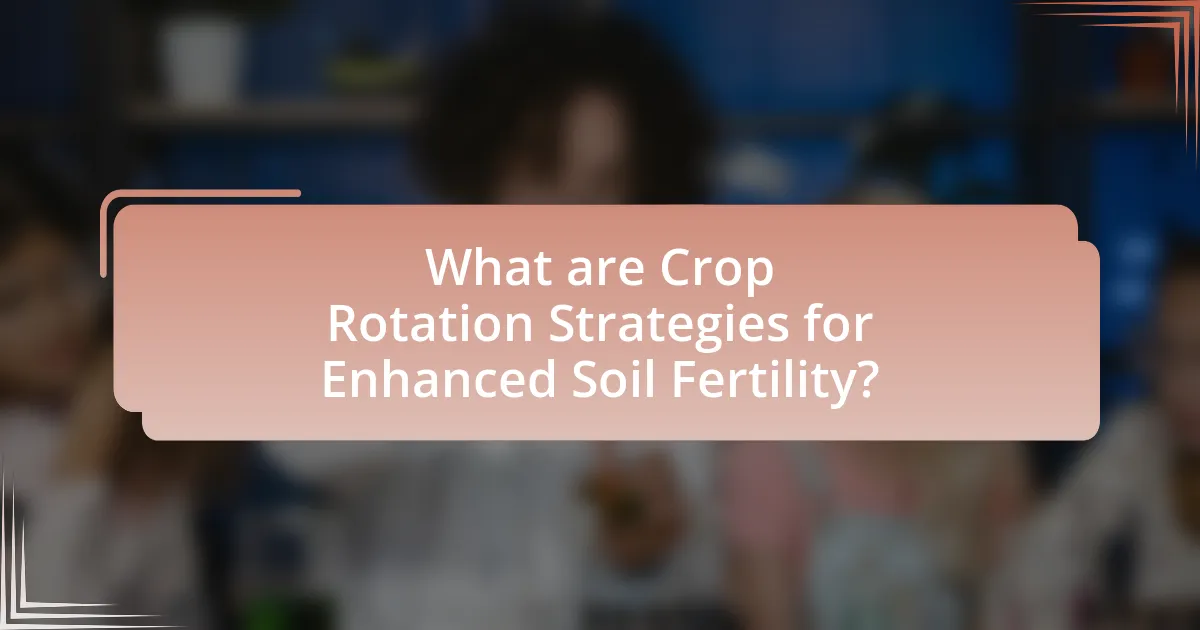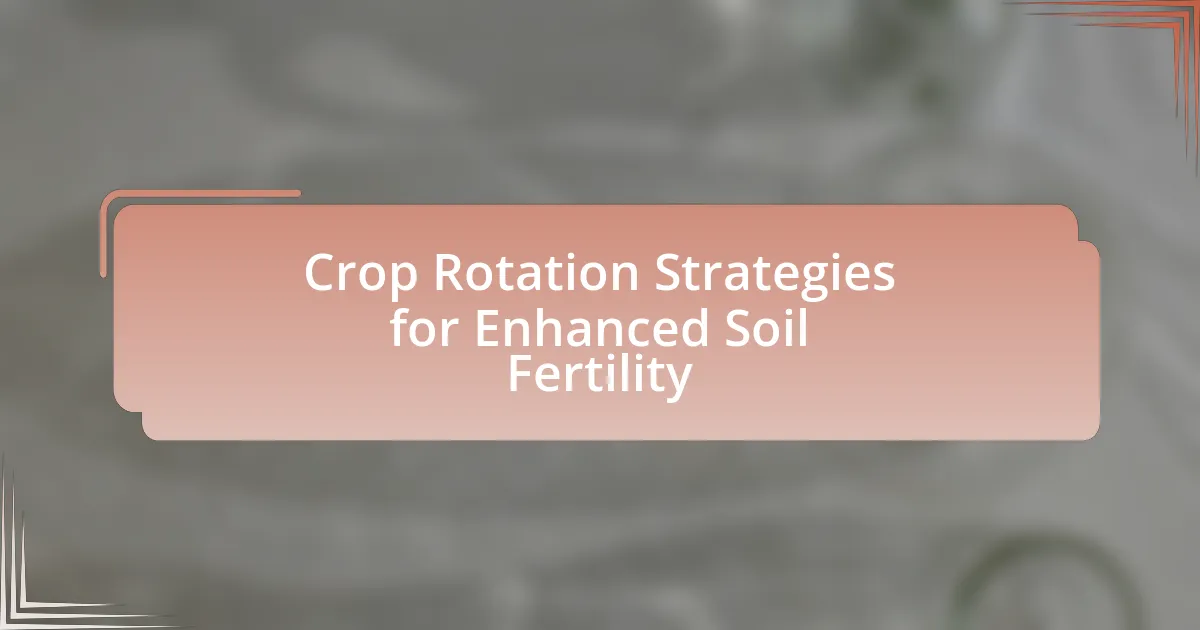Crop rotation strategies for enhanced soil fertility involve the systematic alternation of different crops to improve soil health, nutrient availability, and biodiversity while reducing pest and disease cycles. This practice can lead to significant increases in crop yields, with research indicating a potential boost of 20-30% compared to continuous cropping systems. Key benefits of crop rotation include enhanced nutrient cycling, improved soil structure, and increased microbial activity, which collectively contribute to sustainable agricultural practices. Additionally, various crop rotation methods, such as sequential cropping and cover cropping, are explored, along with the economic implications and best practices for successful implementation.

What are Crop Rotation Strategies for Enhanced Soil Fertility?
Crop rotation strategies for enhanced soil fertility involve systematically alternating different crops in a specific sequence over time to improve soil health and nutrient availability. This practice helps to prevent soil depletion, reduce pest and disease cycles, and enhance biodiversity. For example, rotating legumes, which fix nitrogen in the soil, with cereals that require nitrogen can significantly boost soil fertility. Research indicates that crop rotation can increase yields by 20-30% compared to continuous cropping systems, as demonstrated in studies conducted by the USDA Agricultural Research Service.
How do crop rotation strategies improve soil health?
Crop rotation strategies improve soil health by enhancing nutrient availability, reducing soil erosion, and disrupting pest and disease cycles. By alternating different crops, farmers can optimize nutrient uptake; for instance, legumes fix nitrogen in the soil, benefiting subsequent crops. Research indicates that diverse crop rotations can increase organic matter and microbial activity, which are crucial for soil structure and fertility. A study published in the journal “Agronomy” found that crop rotation can lead to a 20-30% increase in soil organic carbon levels, demonstrating its effectiveness in promoting long-term soil health.
What specific soil nutrients are enhanced through crop rotation?
Crop rotation enhances specific soil nutrients such as nitrogen, phosphorus, and potassium. Leguminous crops, like beans and peas, fix atmospheric nitrogen into the soil, increasing its nitrogen content. Additionally, different crops have varying nutrient uptake patterns, which can help balance soil nutrient levels over time. For instance, rotating deep-rooted plants with shallow-rooted ones can improve phosphorus and potassium availability by accessing different soil layers. Studies have shown that these practices can lead to improved soil fertility and crop yields, demonstrating the effectiveness of crop rotation in nutrient enhancement.
How does crop rotation affect soil structure and microbial activity?
Crop rotation significantly improves soil structure and enhances microbial activity. By alternating different crops, soil structure benefits from varied root systems that create channels for air and water movement, reducing compaction and promoting better drainage. Additionally, diverse crops contribute different organic matter types, which fosters a more diverse microbial community. Research indicates that crop rotation can increase microbial biomass and activity, as seen in studies where rotations involving legumes boosted nitrogen-fixing bacteria, thereby enriching soil fertility and promoting healthier ecosystems.
Why is crop rotation important for sustainable agriculture?
Crop rotation is important for sustainable agriculture because it enhances soil fertility and reduces pest and disease pressure. By alternating different crops, farmers can improve nutrient cycling, as various plants have distinct nutrient requirements and contributions to the soil. For instance, legumes can fix nitrogen, enriching the soil for subsequent crops. Research indicates that crop rotation can lead to a 20-30% increase in crop yields compared to monoculture systems, demonstrating its effectiveness in maintaining agricultural productivity while promoting environmental health.
What are the environmental benefits of implementing crop rotation?
Implementing crop rotation provides significant environmental benefits, including improved soil health, reduced erosion, and enhanced biodiversity. Crop rotation enhances soil fertility by alternating deep-rooted and shallow-rooted plants, which helps maintain nutrient levels and structure. Research indicates that rotating crops can reduce the need for chemical fertilizers by up to 30%, as different plants contribute various nutrients to the soil and utilize them differently. Additionally, crop rotation minimizes pest and disease cycles, leading to lower pesticide use and promoting a more balanced ecosystem. Studies have shown that diverse cropping systems can increase soil organic matter by 1-2% annually, further improving soil quality and carbon sequestration.
How does crop rotation contribute to pest and disease management?
Crop rotation contributes to pest and disease management by disrupting the life cycles of pests and pathogens. When different crops are planted in succession, it reduces the availability of specific host plants for pests and diseases, thereby decreasing their populations. For instance, rotating crops such as legumes with cereals can interrupt the cycles of pests like root maggots and diseases such as Fusarium wilt, which thrive on specific crops. Research indicates that crop rotation can lead to a 30-50% reduction in pest populations and disease incidence, enhancing overall crop health and yield.
What are the common types of crop rotation strategies?
Common types of crop rotation strategies include sequential cropping, cover cropping, and intercropping. Sequential cropping involves planting different crops in a specific sequence over time to improve soil health and reduce pest populations. Cover cropping utilizes specific plants to cover the soil during off-seasons, enhancing soil structure and fertility. Intercropping involves growing two or more crops simultaneously in the same field, which can optimize resource use and increase biodiversity. These strategies are supported by agricultural research indicating that they can lead to improved soil fertility and reduced reliance on chemical fertilizers.
What is the difference between simple and complex crop rotation systems?
Simple crop rotation systems involve alternating two or three crops in a sequence, typically focusing on a limited variety of plants to manage soil nutrients and pests. In contrast, complex crop rotation systems incorporate a wider range of crops, often including legumes, cover crops, and diverse species, which enhances biodiversity and improves soil health by promoting various microbial activities and nutrient cycling. Research indicates that complex systems can lead to better pest control and reduced disease incidence compared to simple systems, as demonstrated in studies showing that diverse rotations can decrease reliance on chemical inputs and improve overall ecosystem resilience.
How do cover crops fit into crop rotation strategies?
Cover crops are integral to crop rotation strategies as they enhance soil health, improve nutrient cycling, and reduce erosion. By planting cover crops between main crop cycles, farmers can increase organic matter in the soil, which boosts microbial activity and nutrient availability. Research indicates that cover crops can reduce nitrogen leaching by up to 50%, thereby improving soil fertility and reducing the need for synthetic fertilizers. Additionally, cover crops help suppress weeds and break pest cycles, contributing to a more sustainable agricultural system.
How can farmers effectively implement crop rotation strategies?
Farmers can effectively implement crop rotation strategies by systematically alternating the types of crops grown in a specific field over time. This practice enhances soil fertility, reduces pest and disease cycles, and improves crop yields. For instance, rotating legumes with cereals can increase nitrogen levels in the soil, as legumes fix atmospheric nitrogen, benefiting subsequent crops. Research indicates that crop rotation can lead to a 10-20% increase in yield compared to continuous cropping systems, as demonstrated in studies conducted by the USDA Agricultural Research Service.
What factors should be considered when planning a crop rotation schedule?
When planning a crop rotation schedule, factors such as soil health, pest and disease management, nutrient requirements, and crop compatibility must be considered. Soil health is crucial as different crops affect soil structure and nutrient levels; for instance, legumes can enhance nitrogen content, benefiting subsequent crops. Pest and disease management is essential because rotating crops can disrupt pest life cycles and reduce disease incidence, as seen in studies showing reduced nematode populations with diverse rotations. Nutrient requirements vary among crops, necessitating a rotation that balances nutrient uptake and replenishment, which can be optimized by alternating deep and shallow-rooted plants. Lastly, crop compatibility ensures that successive crops do not compete for the same resources or exacerbate soil depletion, promoting overall agricultural sustainability.
How can technology assist in optimizing crop rotation practices?
Technology can assist in optimizing crop rotation practices by utilizing data analytics, precision agriculture tools, and remote sensing technologies. These tools enable farmers to analyze soil health, monitor crop performance, and predict optimal planting schedules based on environmental conditions. For instance, data analytics can identify which crops improve soil nutrients and reduce pest populations, leading to more informed decisions about rotation sequences. Additionally, precision agriculture technologies, such as GPS-guided equipment, allow for tailored application of fertilizers and pesticides, enhancing the effectiveness of crop rotations. Remote sensing technologies provide real-time data on crop health and soil moisture, facilitating timely interventions that support sustainable practices.
What challenges might farmers face with crop rotation?
Farmers may face several challenges with crop rotation, including pest and disease management, soil nutrient depletion, and market demand fluctuations. Pest and disease pressures can shift with different crops, potentially leading to increased infestations or outbreaks if not managed properly. Additionally, certain crops may require specific nutrients, which can lead to soil nutrient depletion if not balanced with complementary crops. Market demand can also vary, making it difficult for farmers to predict which crops will be profitable in the future, thus complicating their rotation planning. These challenges necessitate careful planning and management to ensure successful crop rotation practices.
How can farmers overcome the challenges of crop rotation?
Farmers can overcome the challenges of crop rotation by implementing diverse planting schedules and selecting complementary crops. This approach enhances soil fertility and reduces pest and disease cycles. For instance, rotating legumes with cereals can improve nitrogen levels in the soil, as legumes fix atmospheric nitrogen, benefiting subsequent crops. Research indicates that farms practicing diverse crop rotations can yield up to 20% more than those using monoculture systems, demonstrating the effectiveness of this strategy in maintaining soil health and productivity.
What are the economic implications of adopting crop rotation strategies?
Adopting crop rotation strategies leads to increased economic benefits for farmers through enhanced soil fertility and reduced input costs. Crop rotation improves soil health by preventing nutrient depletion and reducing pest and disease cycles, which can lower the need for chemical fertilizers and pesticides. For instance, a study by the USDA found that rotating legumes with cereals can increase nitrogen availability in the soil, resulting in a 20% reduction in fertilizer costs. Additionally, diversified crop production can lead to higher market resilience and profitability, as farmers can adapt to changing market demands and reduce the risk of crop failure. Overall, the economic implications of crop rotation strategies are significant, as they contribute to sustainable farming practices that enhance productivity and profitability.
What best practices should be followed for successful crop rotation?
Successful crop rotation requires diversifying crops to improve soil health and reduce pests. Implementing a rotation plan that includes legumes can enhance nitrogen levels in the soil, as legumes fix atmospheric nitrogen. Additionally, rotating deep-rooted and shallow-rooted crops helps in utilizing different soil layers, promoting better nutrient uptake. It is also essential to avoid planting the same family of crops consecutively, as this can lead to the buildup of specific pests and diseases. Research indicates that farms practicing effective crop rotation can see yield increases of up to 20% due to improved soil structure and fertility.
How can farmers monitor and evaluate the effectiveness of their crop rotation?
Farmers can monitor and evaluate the effectiveness of their crop rotation by analyzing soil health indicators, crop yield data, and pest and disease prevalence. Soil tests can reveal nutrient levels, pH, and organic matter content, which help assess the impact of different crops on soil fertility. Additionally, tracking crop yields over multiple seasons allows farmers to identify trends and determine which rotations maximize productivity. Monitoring pest and disease occurrences can indicate the success of rotations in breaking pest cycles and reducing infestations. Research shows that diverse crop rotations can improve soil structure and fertility, leading to better overall crop performance.
What resources are available for farmers looking to implement crop rotation?
Farmers looking to implement crop rotation can access a variety of resources, including agricultural extension services, university research publications, and online platforms dedicated to sustainable farming practices. Agricultural extension services provide localized advice and support tailored to specific regions, helping farmers understand the benefits and techniques of crop rotation. University research publications often contain studies and guidelines on effective crop rotation strategies, showcasing data on yield improvements and soil health benefits. Online platforms, such as the Sustainable Agriculture Research and Education (SARE) program, offer comprehensive resources, including case studies, webinars, and best practice guides that facilitate the adoption of crop rotation for enhanced soil fertility.


